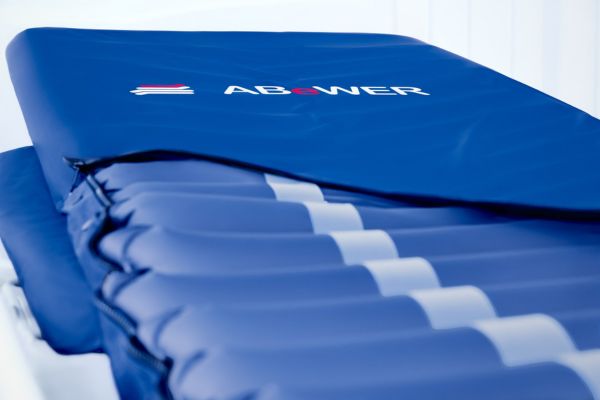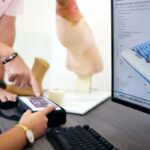Immobile patients face serious risk of developing pressure injuries when they can’t naturally shift their weight. Automated lateral turning technology addresses this by continuously repositioning patients and managing pressure – tasks that manual care schedules struggle to maintain consistently around the clock.
Why Immobility Creates Urgent Medical Risk
Your body makes thousands of micro-adjustments while you sleep. You shift weight, change positions, and redistribute pressure without thinking about it. These movements happen automatically to keep blood flowing and prevent tissue damage.
Patients recovering from spinal cord injuries, strokes, or major surgery lose this ability. Their bodies can’t make those crucial adjustments, which means pressure builds up until blood flow stops. Pressure injuries can develop within hours when someone remains completely still.
The medical consequences compound quickly. Stage 1 pressure injuries show as reddened skin that won’t blanch when pressed. Stage 2 involves open skin and blisters. Stage 3 reaches into subcutaneous fat. Stage 4 exposes bone, tendon, or muscle. Each stage requires more intensive treatment and extends hospital stays.
Deep tissue pressure injuries (DTPI) present additional challenges. Damage occurs in deeper tissue layers before anything shows on the skin surface. By the time visible changes appear, significant internal damage may already exist.

The Reality of Two-Hour Repositioning Schedules
Standard hospital protocol calls for repositioning immobile patients every two hours. On paper, it sounds manageable. In practice, maintaining this schedule consistently faces significant obstacles.
Manual repositioning requires two to three staff members for safe patient handling. That’s six to nine staff hours per patient per day just for basic positioning. In a 20-bed unit, you’re looking at 120 to 180 staff hours daily spent on manual turns alone.
Night shifts run with reduced staffing levels. Emergencies pull staff away from scheduled tasks. One patient codes, and suddenly the two-hour window stretches to three or four hours for everyone else on the unit. It’s not negligence – it’s the reality of healthcare delivery when resources are stretched thin.
Manual repositioning also disrupts patient sleep. Patients recovering from surgery, managing chronic conditions, or dealing with critical illness need uninterrupted rest for optimal healing. Yet traditional repositioning schedules inherently interrupt sleep cycles every two hours.
The physical demands on healthcare workers add another dimension. Repositioning immobile patients requires proper body mechanics and physical strength. Staff injuries from patient handling represent a significant occupational hazard in healthcare settings.
How Automated Lateral Turning Technology Works
The MultiTurn® 6 automated lateral turning mattress handles patient repositioning continuously without manual intervention. The system turns patients 30° to each side at adjustable intervals: 30, 60, or 90 minutes depending on the patient’s risk level and medical condition.
The 30-minute interval setting specifically addresses the highest-risk cases: patients with DTPI, existing Stage 3 or Stage 4 pressure ulcers, or challenging wounds that need maximum pressure relief. More frequent turning prevents additional tissue damage while supporting healing in existing injuries.
Air cells inflate on one side while the other side deflates, rocking the patient gently from side to side. It feels more like natural sleep movement than a machine repositioning you. At under 20 decibels (quieter than whispering), patients sleep through it.
An anti-collapse feature maintains turning quality and keeps continuous low pressure on the body even during position changes. This ensures effective pressure redistribution throughout every cycle.
Combining Lateral Turning with Pressure Redistribution
Automated turning alone wouldn’t fully address pressure injury risk. The MultiTurn® 6 combines lateral turning with two additional pressure management technologies.
Alternating pressure technology uses 18 separate air tubes that inflate and deflate in programmed patterns. You can set the cycles to 12, 18, or 24 minutes. Group A cells inflate while Group B deflates, then they switch. This shifts pressure around the body in patterns – no spot gets pressed long enough to cut off blood flow.
Continuous Low Pressure (CLP) management maintains baseline pressure reduction across the entire mattress surface. While the other systems actively move and redistribute pressure, CLP prevents pressure buildup between cycles.
The mattress surface includes laser-cut air holes that allow continuous airflow to the patient’s body. This addresses microclimate management: temperature and moisture levels around the skin. Moisture buildup makes skin more vulnerable to pressure damage, so keeping patients dry matters beyond just mechanical pressure management.
Patient Populations That Benefit Most
Spinal cord injury patients face lifelong pressure injury risk. Their complete lack of sensation below the injury level means they can’t feel early warning signs that healthy people use to shift position. These patients need reliable, continuous pressure management indefinitely.
Surgical recovery patients, especially after orthopedic, cardiovascular, or neurological procedures, often require extended bed rest during initial healing. Their mobility limitations are temporary, but the pressure injury risk during this period remains acute.
ICU patients with multiple medical conditions can’t tolerate additional complications. Sepsis, respiratory failure, and organ dysfunction all increase tissue vulnerability. For these patients, pressure injury prevention isn’t just about comfort – it’s about survival.
Nursing home residents with limited mobility need ongoing pressure management. Chronic conditions like diabetes, peripheral vascular disease, and advanced age all compromise tissue integrity. Automated systems provide consistent protection that doesn’t depend on staffing levels or competing care priorities.
The MultiTurn® 6 accommodates patients up to 180kg, covering most adult populations. The system’s dimensions (200cm x 80cm x 11.5cm) fit standard hospital bed frames without requiring special equipment or facility modifications.
Supporting Patient Independence
Patients with upper body mobility get a remote control for making positioning adjustments between automated cycles. For someone with paraplegia, being able to adjust their position without calling for help preserves dignity during recovery.
The control includes options for head elevation (up to 45°), leg elevation, and minor position changes. These adjustments don’t override the automated pressure management protocols. They work within the system’s parameters to support patient comfort and autonomy.
Head and leg elevation capabilities also support clinical care requirements. Respiratory treatments often require elevated head positioning. Wound care may need specific body angles for access. The MultiTurn® 6 accommodates these clinical needs while maintaining pressure redistribution effectiveness.
Installation and Power Requirements
The system runs on standard 220-240V electrical systems with 50-60Hz. No special electrical infrastructure or power configurations needed. Adapters accommodate different international power standards, making the system suitable for hospitals, rehabilitation centers, nursing homes, and home care environments worldwide.
The pump unit measures 28cm x 10.2cm x 16.5cm and weighs 1.6kg. The mattress weighs 8.6kg. Setup involves connecting the power cord and air hose connector, straightforward enough for facility staff without requiring specialized technical support.
The control panel uses an LCD touchscreen with clear indicators for system status, pressure levels, and settings. Visual and audible alarms alert staff to issues like air leakage or insufficient pressure. The alarm can be temporarily muted (the system re-evaluates pressure after 4 minutes and sounds again if problems persist).
For CPR emergencies, pulling the red strip quickly deflates the mattress, ensuring the system doesn’t interfere with emergency medical procedures.
Maintenance Requirements
The separate airbag design means individual air tubes can be replaced if damaged without replacing the entire mattress. This modular approach reduces long-term maintenance costs and keeps the system operational even if one component fails.
The waterproof cover uses welded, seam-sealed construction with vapor-permeable stretch PU material. It can be cleaned with soft cloth, soap, and water. The breathable TPU material maintains its properties through repeated sterilization cycles with hospital disinfectants.
Regular filter changes maintain optimal pump performance. The external, easy-to-replace filters don’t require technical expertise to service. ABeWER provides a 24-month warranty on the pump system, reflecting confidence in long-term reliability under continuous use.
Medical Device Certification
The MultiTurn® 6 carries CE certification under EU MDR 2017/745. Getting certified meant passing tests on electrical safety, whether the materials are safe against skin for weeks at a time, mechanical durability, and whether it works reliably when running 24/7.
Class II medical device classification puts it in the moderate-risk category. That means stricter rules on manufacturing processes, quality checks, and clinical documentation than lower-risk devices.
The system meets several standards: EN ISO 13485:2016 for quality management, IEC60601 specifications for electrical safety and performance, EN10993 standards for biological safety, and ISO14971:2012 for risk management.
Real-World Implementation
Healthcare facilities implementing automated lateral turning technology report several operational benefits. Nursing time previously spent on manual repositioning becomes available for tasks requiring professional judgment: medication administration, wound assessment, family communication, and complex clinical decision-making.
Documentation simplifies. Instead of charting each manual repositioning event with timestamps and staff signatures, providers focus on assessing patient response and adjusting care plans. The automated system handles the basic positioning protocol continuously.
Pressure injury rates typically decline after implementation. While prevention can’t be guaranteed for every patient, consistent pressure management reduces risk across patient populations. The reduction in pressure injury complications affects both patient outcomes and facility quality metrics.
Prevention Before Treatment
Treating a Stage 4 pressure injury takes weeks or months of intensive wound care. Preventing that same injury from developing in the first place requires consistent pressure management from day one of immobility.
For patients who can’t reposition themselves, that prevention needs to work 24 hours daily without depending on staffing levels, shift changes, or competing clinical priorities. Automated lateral turning technology provides this consistency.
ABeWER spent 30 years developing pressure injury prevention technology before releasing the MultiTurn® 6. The core problem they solved: immobile patients can’t do what healthy sleepers do naturally – shift positions to keep blood flowing and prevent tissue damage.



